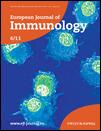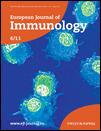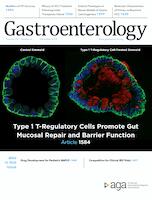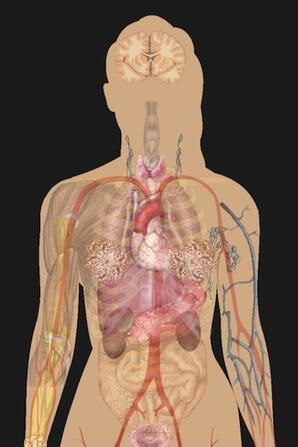Weisser, Shelley B.
Person Preferred Name
Shelley Weisser
Position
Faculty Member
Field of Activity
Immunology
Medical Genetics
Cancer Biology
Inflammatory Diseases
Email/Contact
weissers@douglascollege.ca
Department
Status
current
Education and Credentials
PhD (University of British Columbia)
MSc (University of British Columbia)
BSc (University of British Columbia)
PhD (University of British Columbia)
MSc (University of British Columbia)
BSc (University of British Columbia)
Related Works
Content type
Digital Document
Abstract
Alternatively activated macrophages are critical in host defense against parasites and are protective in inflammatory bowel disease, but contribute to pathology in asthma and solid tumors. The mechanisms underlying alternative activation of macrophages are only partially understood and little is known about their amenability to manipulation in pathophysiological conditions. Herein, we demonstrate that Src homology 2-domain-containing inositol-5'-phosphatase (SHIP)-deficient murine macrophages are more sensitive to IL-4-mediated skewing to an alternatively activated phenotype. Moreover, SHIP levels are decreased in macrophages treated with IL-4 and in murine GM-CSF-derived and tumor-associated macrophages. Loss of SHIP and induction of alternatively activated macrophage markers, Ym1 and arginase I (argI), were dependent on phosphatidylinositol 3-kinase (PI3K) activity and argI induction was dependent on the class IA PI3Kp110δ isoform. STAT6 was required to reduce SHIP protein levels, but reduced SHIP levels did not increase STAT6 phosphorylation. STAT6 transcription was inhibited by PI3K inhibitors and enhanced when SHIP was reduced using siRNA. Importantly, reducing SHIP levels enhanced, whereas SHIP overexpression or blocking SHIP degradation reduced, IL-4-induced argI activity. These findings identify SHIP and the PI3K pathway as critical regulators of alternative macrophage activation and SHIP as a target for manipulation in diseases where macrophage phenotype contributes to pathology.
Origin Information
Content type
Digital Document
Abstract
Macrophages are critical players in the innate immune response to infectious challenge or injury, initiating the innate immune response and directing the acquired immune response. Macrophage dysfunction can lead to an inability to mount an appropriate immune response and as such, has been implicated in many disease processes, including inflammatory bowel diseases. Macrophages display polarized phenotypes that are broadly divided into two categories. Classically activated macrophages, activated by stimulation with IFNγ or LPS, play an essential role in response to bacterial challenge whereas alternatively activated macrophages, activated by IL-4 or IL-13, participate in debris scavenging and tissue remodeling and have been implicated in the resolution phase of inflammation. During an inflammatory response in vivo, macrophages are found amid a complex mixture of infiltrating immune cells and may participate by exacerbating or resolving inflammation. To define the role of macrophages in situ in a whole animal model, it is necessary to examine the effect of depleting macrophages from the complex environment. To ask questions about the role of macrophage phenotype in situ, phenotypically defined polarized macrophages can be derived ex vivo, from bone marrow aspirates and added back to mice, with or without prior depletion of macrophages. In the protocol presented here clodronate-containing liposomes, versus PBS injected controls, were used to deplete colonic macrophages during dextran sodium sulfate (DSS)-induced colitis in mice. In addition, polarized macrophages were derived ex vivo and transferred to mice by intravenous injection. A caveat to this approach is that clodronate-containing liposomes deplete all professional phagocytes, including both dendritic cells and macrophages so to ensure the effect observed by depletion is macrophage-specific, reconstitution of phenotype by adoptive transfer of macrophages is necessary. Systemic macrophage depletion in mice can also be achieved by backcrossing mice onto a CD11b-DTR background, which is an excellent complementary approach. The advantage of clodronate-containing liposome-mediated depletion is that it does not require the time and expense involved in backcrossing mice and it can be used in mice regardless of the background of the mice (C57BL/6, BALB/c, or mixed background).
Origin Information
Content type
Digital Document
Abstract
The chapter, "Generation and characterization of murine alternatively activated macrophages" was written by the listed authors including Shelley B. Weisser (Douglas College Faculty). Part of the "Methods in Molecular Biology (Methods and Protocols)" book series (MIMB, volume 946): For over 35 years, biological scientists have come to rely on the research protocols and methodologies in the critically acclaimed Methods in Molecular Biology series. The series was the first to introduce the step-by-step protocols approach that has become the standard in all biomedical protocol publishing. Each protocol is provided in readily-reproducible step-by step fashion, opening with an introductory overview, a list of the materials and reagents needed to complete the experiment, and followed by a detailed procedure that is supported with a helpful notes section offering tips and tricks of the trade as well as troubleshooting advice. These hallmark features were introduced by series editor Dr. John Walker and constitute the key ingredient in each and every volume of the Methods in Molecular Biology series. Tested and trusted, comprehensive and reliable, all protocols from the series are indexed in PubMed. <p>
<p> Book "Basic Cell Culture Protocols": At some point in their careers, virtually every scientist and technician, as well as many medical professionals, regardless of their area of specialization have a need to utilize cell culture systems. Updating and significantly expanding upon the previous editions, Basic Cell Culture Protocols, Fourth Edition provides the novice cell culturist with sufficient information to perform the basic techniques, to ensure the health and identity of their cell lines, and to be able to isolate and culture specialized primary cell types. The intent of this extensive volume is to generate a valuable resource containing clear methodologies pertinent to current areas of investigation, rather than attempting to educate cell culturists on specific cell types or organ systems. Written in the highly successful Methods in Molecular Biology™, chapters include introductions to their respective topics, lists of the necessary materials and reagents, step-by-step, readily reproducible laboratory protocols, and tips on troubleshooting and avoiding known pitfalls.
Comprehensive and up-to-date, Basic Cell Culture Protocols, Fourth Edition compiles the essential techniques needed to approach this vital laboratory activity with full success.
<p>Book Chapter: Macrophages play a key role in the innate immune response and help to direct the acquired immune response. Early in the innate immune response, they produce reactive oxygen species and pro-inflammatory cytokines and chemokines to drive inflammation and are referred to as “classically activated” or “killer” macrophages (M1). During the resolution phase of inflammation, they switch to what is known as an “alternatively activated” phenotype or “healer” macrophage (M2) and contribute to debris scavenging, angiogenesis, and wound healing. M1 macrophages are activated by treatment with IFNγ or LPS and M2 macrophages are activated by treatment with Th2 cytokines IL-4 or IL-13 and the M2 phenotype switch can be enhanced by IL-10. Macrophages can also be skewed during differentiation in vitro, and the resultant phenotype depends upon the cytokine provided to support their differentiation. In murine macrophages, MCSF promotes differentiation to an M1 phenotype, GM-CSF promotes differentiation to an M2 phenotype and IL-3 promotes differentiation into a profoundly M2 skewed phenotype. A defining feature of the phenotype of murine M1 versus M2 macrophages is how they metabolize L-arginine. In response to an inflammatory stimulus like LPS, M1 macrophages produce inducible nitric oxide synthase (iNOS) which uses L-arginine as a substrate to produce nitric oxide (NO). M2 macrophages constitutively produce the enzyme arginase I (argI), which sequesters L-arginine from iNOS and results in the production of ornithine and downstream polyamines and L-proline. M1 macrophages also produce relatively higher levels of pro-inflammatory IL-12 and lower levels of anti-inflammatory IL-10 relative to M2 macrophages. In this chapter, we describe in vitro derivation of polarized bone marrow macrophages and methods to analyze the resulting phenotype including Q-PCR, Western blotting, and enzyme assays to determine argI and iNOS expression and activity, as well as production of IL-12p40 and IL-10 and determination of IL-12/IL-10 ratios. Production of iNOS, NO, IL-12p40, and IL-10 are measured after treatment with LPS.
Origin Information
Content type
Digital Document
Abstract
Inflammatory bowel disease (IBD) is an idiopathic disease characterized by chronic intestinal
inflammation and ulceration. Canada has the highest incidence of IBD in the world with 1 in
150 people affected. While treatment options target symptoms and attempt to dampen down
inflammation, an increasing population of patients is refractory to current therapeutic
options. Macrophages are heterogeneous in their functions and while it is clear that
inflammatory macrophages contribute to inflammation in IBD, multiple lines of evidence
suggest that alternatively activated macrophages may offer protection during intestinal
inflammation. In vivo SHIP deficient mouse macrophages are alternatively activated so
SHIP deficient mice provide a unique genetic model of alternative macrophage activation.
Using the dextran sodium sulfate (DSS)-induced model of colitis, I found that SHIP-/- mice
are protected during induced intestinal inflammation, the protection is macrophage mediated,
and can be conferred to a susceptible host. To determine how SHIP contributes to alternative
activation of macrophages, I demonstrate that SHIP-deficient murine macrophages are more
sensitive to IL-4-mediated skewing to an alternatively activated phenotype. Moreover, SHIP
levels are reduced in alternatively activated macrophages and this is required for alternative
activation because it is dependent on PI3K activity. Arginase (ArgI) induction is specifically
dependent on the PI3Kp110δ isoform of class IA PI3K. As such, mice deficient in
PI3Kp110δ catalytic subunit activity have increased clinical disease activity and histological
damage during DSS-induced colitis. Colitis severity correlates with reduced numbers of
ArgI+ M2 macrophages in the colon, increased nitric oxide production, and is macrophagedependent. Importantly, adoptive transfer of IL-4-treated macrophages from wild type mice,
but not from PI3Kp110δ deficient mice, protects mice during DSS-induced colitis. Protection is lost when mice are treated with inhibitors that block arginase activity showing that ArgI
activity is required for M2 macrophage-mediated protection from intestinal inflammation.
These findings identify SHIP and the PI3K pathway as critical regulators of alternative
macrophage activation and as potential targets for manipulation in IBD. In addition,
adoptive transfer of alternatively activated macrophages to patients with IBD also offers a
promising, new strategy for treatment that may be particularly useful in patients who are
refractory to conventional therapies.
Origin Information
Content type
Digital Document
Abstract
mφ are heterogeneous in their functions, and although it is clear that inflammatory mφ contribute to inflammation in IBDs, multiple lines of evidence suggest that M2a mφ may offer protection during intestinal inflammation. In vivo SHIP‐deficient mouse mφ are M2a so SHIP‐deficient mice provide a unique genetic model of M2a mφ. Based on this, this study tested the hypothesis that SHIP‐deficient, M2a mφ protect mice from intestinal inflammation. The objectives were to compare the susceptibility of SHIP+/+ and SHIP−/− littermates with DSS‐induced intestinal inflammation and to determine whether protection was mφ‐mediated and whether protection could be transferred to a susceptible host. We have found that SHIP−/− mice are protected during DSS‐induced intestinal inflammation. SHIP−/− mice have delayed rectal bleeding and reduced weight loss, disruption of intestinal architecture, and immune cell infiltration during DSS‐induced colitis relative to their WT littermates. Using liposome depletion of mφ, we found that SHIP−/− mouse protection was indeed mφ‐mediated. Finally, we determined that SHIP−/− mφ‐mediated protection could be conferred to susceptible WT mice by adoptive transfer of M2a mφ derived ex vivo. This study supports our hypothesis by demonstrating that SHIP‐deficient, M2a mφ are protective in this murine model of acute intestinal inflammation. Adoptive transfer of M2a mφ to patients with IBDs offers a promising, new strategy for treatment that may be particularly useful in patients who are otherwise refractory to conventional therapies.
Origin Information
Content type
Digital Document
Abstract
Alternatively activated or M2 macrophages have been reported to protect mice from intestinal inflammation, but the mechanism of protection has not been elucidated. In this study, we demonstrate that mice deficient in the p110δ catalytic subunit activity of class I phosphatidylinositol 3-kinase (PI3Kp110δ) have increased clinical disease activity and histological damage during dextran sodium sulfate (DSS) induced colitis. Increased disease severity in PI3Kp110δ-deficient mice is dependent on professional phagocytes and correlates with reduced numbers of arginase I+ M2 macrophages in the colon and increased production of inflammatory nitric oxide. We further demonstrate that PI3Kp110δ-deficient macrophages are defective in their ability to induce arginase I when skewed to an M2 phenotype with IL-4. Importantly, adoptive transfer of IL-4-treated macrophages derived from WT mice, but not those from PI3Kp110δ-deficient mice, protects mice during DSS-induced colitis. Moreover, M2 macrophages mediated protection is lost when mice are cotreated with inhibitors that block arginase activity or during adoptive transfer of arginase I deficient M2 macrophages. Taken together, our data demonstrate that arginase I activity is required for M2 macrophages mediated protection during DSS-induced colitis in PI3Kp110δ-deficient mice.
Origin Information
Content type
Digital Document
Abstract
Intestinal fibrosis is a serious complication of Crohn's disease (CD) that can lead to stricture formation, which requires surgery. Mechanisms underlying intestinal fibrosis remain elusive because of a lack of suitable mouse models. Herein, we describe a spontaneous mouse model of intestinal inflammation with fibrosis and the profibrotic role of arginase I. The Src homology 2 domain–containing inositol polyphosphate 5′-phosphatase–deficient (SHIP –/–) mice developed spontaneous discontinuous intestinal inflammation restricted to the distal ileum starting at the age of 4 weeks. Mice developed several key features resembling CD, including inflammation and fibrosis. Inflammation was characterized by abundant infiltrating Gr-1–positive immune cells, granuloma-like immune cell aggregates that contained multinucleated giant cells, and a mixed type 2 and type 17 helper T-cell cytokine profile. Fibrosis was characterized by a thickened ileal muscle layer, collagen deposition, and increased fibroblasts at the sites of collagen deposition. SHIP –/– ilea had increased arginase activity and arginase I expression that was inversely proportional to nitrotyrosine staining. SHIP –/– mice were treated with the arginase inhibitor S-(2-boronoethyl)- l-cysteine, and changes in the disease phenotype were measured. Arginase inhibition did not affect the number of immune cell infiltrates in the SHIP –/– mouse ilea; rather, it reduced collagen deposition and muscle hyperplasia. These findings suggest that arginase activity is a potential target to limit intestinal fibrosis in patients with CD.
Origin Information
Content type
Digital Document
Abstract
Background & Aims
Crohn’s disease (CD) is associated with a dysregulated immune response to commensal micro-organisms in the intestine. Mice deficient in inositol polyphosphate 5′-phosphatase D (INPP5D, also known as SHIP) develop intestinal inflammation resembling that of patients with CD. SHIP is a negative regulator of PI3Kp110α activity. We investigated mechanisms of intestinal inflammation in Inpp5d−/− mice (SHIP-null mice), and SHIP levels and activity in intestinal tissues of subjects with CD.
<p>Methods
We collected intestines from SHIP-null mice, as well as Inpp5d+/+ mice (controls), and measured levels of cytokines of the interleukin 1 (IL1) family (IL1α, IL1β, IL1ra, and IL6) by enzyme-linked immunosorbent assay. Macrophages were isolated from lamina propria cells of mice, IL1β production was measured, and mechanisms of increased IL1β production were investigated. Macrophages were incubated with pan−phosphatidylinositol 3-kinase inhibitors or PI3Kp110α-specific inhibitors. Some mice were given an antagonist of the IL1 receptor; macrophages were depleted from ilea of mice using clodronate-containing liposomes. We obtained ileal biopsies from sites of inflammation and peripheral blood mononuclear cells (PBMCs) from treatment-naïve subjects with CD or without CD (controls), and measured SHIP levels and activity. PBMCs were incubated with lipopolysaccharide and adenosine triphosphate, and levels of IL1β production were measured.
<p>Results
Inflamed intestinal tissues and intestinal macrophages from SHIP-null mice produced higher levels of IL1B and IL18 than intestinal tissues from control mice. We found PI3Kp110α to be required for macrophage transcription of Il1b. Macrophage depletion or injection of an IL1 receptor antagonist reduced ileal inflammation in SHIP-null mice. Inflamed ileal tissues and PBMCs from patients with CD had lower levels of SHIP protein than controls (P < .0001 and P < .0002, respectively). There was an inverse correlation between levels of SHIP activity in PBMCs and induction of IL1β production by lipopolysaccharide and adenosine triphosphate (R2 = .88).
<p>Conclusions
Macrophages from SHIP-deficient mice have increased PI3Kp110α-mediated transcription of Il1b, which contributes to spontaneous ileal inflammation. SHIP levels and activity are lower in intestinal tissues and peripheral blood samples from patients with CD than controls. There is an inverse correlation between SHIP activity and induction of IL1β production by lipopolysaccharide and adenosine triphosphate in PBMCs. Strategies to reduce IL1B might be developed to treat patients with CD found to have low SHIP activity.
Origin Information
Content type
Digital Document
Abstract
This textbook is a project under development by our Biology faculty to ultimately provide students with all the factual information they need to succeed in the BIOL 1203 and BIOL 1209 courses at Douglas College in BC, Canada. It was developed initially as an adaptation of the OpenStax Anatomy & Physiology textbook, freely available online at http://cnx.org/content/col11496/latest/. The original adaptations of that OpenStax textbook for Douglas College are accessible online at https://pressbooks.bccampus.ca/dcbiol11031109/ and https://pressbooks.bccampus.ca/dcbiol12031209/ In the first edition of the Douglas College adaptations the chapter and section numbers were left as they were in the version of the OpenStax A&P textbook, from which they were largely drawn. However, this second edition has been more extensively edited and rearranged to correspond with the curriculum used at Douglas College, so chapter and section numbers are no longer aligned specifically with the OpenStax A&P textbook.
Origin Information







